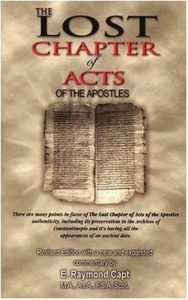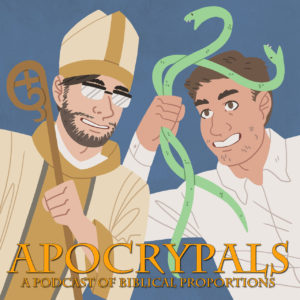2018 New Testament Apocrypha Course: Week 8
Classes at York University are mostly suspended as a result of a rather lengthy strike of our sessional, contract, and graduate student instructors. In order for my students to finish up the course, I resumed classes this past week in an online form, with weekly video lectures and chat room discussions. It is not an ideal way to conduct my courses, but it allows me to honor the strikers by not crossing the picket lines, and honor the students by helping them complete their courses. If you are interested in watching the video lecture, you can see it on Youtube (it’s nothing fancy, but gets the job done).
This week we covered the apocryphal acts, a corpus of material that typically does not excite students. Jesus appears very little in the texts and, let’s face it, the apocryphal acts are rather long and tedious. That said, our sourcebook for the course (Ehrman’s Lost Scriptures) reduces the texts well to their more interesting components. And hey, who can resist tales of necrophilia and severed genitals?
 I started by providing a little context to the texts with a discussion of the canonical Acts, noting, among other things, the text’s depiction of Simon Magus and its abrupt ending with Paul in Rome. This led to a brief look at two modern apocrypha: the 29th Chapter of Acts and the Long-lost Second Book of Acts. Both continue Paul’s missionary work, either in Britain or in Palestine, and give the authors’ opportunity to expound their views on nineteenth-century topics of interest.
I started by providing a little context to the texts with a discussion of the canonical Acts, noting, among other things, the text’s depiction of Simon Magus and its abrupt ending with Paul in Rome. This led to a brief look at two modern apocrypha: the 29th Chapter of Acts and the Long-lost Second Book of Acts. Both continue Paul’s missionary work, either in Britain or in Palestine, and give the authors’ opportunity to expound their views on nineteenth-century topics of interest.
Returning to the apocryphal acts, I provided some background on the five earliest texts— the Acts of Thomas, Andrew, Peter, Paul, and John—with particular attention to Stevan Davies’ theory that the acts were written and transmitted by a community of Christian women (the “widows” discussed in some NT texts). The theory was an effective lead-in to the Acts of Paul and Thecla, in which its female protagonist escapes execution for failing to fulfill her community’s command for her to marry and, after baptizing herself(!), goes on to become a wandering Christian preacher. When I teach this material in class, I show a clip from the Banned from the Bible documentary in which the text is called “feminist.” Perhaps, as critics of Davies’ position have stated, it is too much to expect this ancient Christian text to be so progressive, that in the end the women of the apocryphal acts still function as property to be fought over by the apostles of the text, but it is helpful to consider in this regard Tertullian’s condemnation of the text from On Baptism: he objected to its use by some Christians as support for women preaching and baptizing. So there was some real-world impact of the depiction of women in these texts.
After a brief look at two other Pauline apocrypha—Epistle to the Laodiceans and Epistles of Paul and Seneca, I moved on to the Acts of John. I saved most of the discussion on the text for the online chat, which was a quite spirited exchange about the text’s ascetic qualities (e.g., the story of John expelling bed bugs from his bed, the young man who cut off his genitals and threw them at the woman who tempted him, and the story of Drusiana and Callimachus). I mentioned that the apocryphal acts take their inspiration from Greco-Roman novels. It is worth adding here some features of these novels are apparent in the vulgarity of stories like that of Drusiana and Callimachus story. In Daphnis and Chloe, written in the second century by Longus, Daphnis is educated on love-making by a woman named Lycaenion, but is scared to test his skills on Chloe, because Lycaenion tells him Chloe “will scream and cry and lie bleeding heavily [as if murdered].” Chloe is courted by suitors who try to abduct her and, at one point, is very nearly raped by pirates. The Golden Ass by Lucius features a scene in which the protagonist, transformed by magic into a donkey, has sex with a woman who becomes enamoured with him. Despite all of these crude features, the novels (Acts of John included) seek to edify as much as entertain—i.e., they direct their readers to higher spiritual or moral lessons. The stories may have their objectionable qualities but, to use a modern proverb, these were the spoonful of sugar to help the medicine go down.
I turned next to the Acts of Peter. Only two-thirds of this text now survives and the bulk of it is found in a Latin translation in the Codex Vercellenses. I discussed Matthew Baldwin’s theory (see Whose Acts of Peter? Text and Historical Context of the Actus Vercellenses, 2005) that the Latin translation transformed the original text by introducing the theme of repentance and forgiveness, perhaps due to debate in the church over what to do about lapsi. It is suspicious that the theme of asceticism, so common in the other early apocryphal acts, is absent, except in the Greek manuscripts of the martyrdom. Another source for Acts of Peter that we discussed is a manuscript from the Angelic Library in Rome (Angelicus graecus 108) which features a brief text called “From the Acts of the Holy Apostle Peter.” The manuscript was edited by Francois Bovon and Bertrand Bouvier in 2006 (see “Un fragment grec inédit des Actes de Pierre?” Apocrypha 17: 9-54) but seems not to have made much impact on scholarship on the text. It is set to appear, however, in the forthcoming second volume of New Testament Apocrypha: More Noncanonical Scriptures, along with three other Petrine apocrypha translated by James Walters.
I finished the Acts of Peter with two film clips. The first is a scene from Quo Vadis (1951; watch it HERE), based on the 1896 novel by Polish writer Henryk Sinkiewicz. The title is Latin for “Where are you going, Lord?” and is an allusion to an episode from the Acts of Peter 35. The second clip (a combination of clips actually) is from The Silver Chalice (1954; watch it HERE) based on the 1952 novel by Thomas B. Costain. Here Simon Magus, played by Jack Palance, is presented as a magician used by the Sanhedrin to produce doubt about the miracles of Jesus—if Simon can duplicate the miracles through trickery, then Jesus cannot be the Messiah. Things go awry when Simon starts to believe he does have magic powers. In the Petrine apocrypha, the two compete several times, both in Rome and Palestine, but in The Silver Chalice, Peter and Simon never meet because, Peter says, the Lord had not instructed him to do so. Peter believes Simon will defeat himself. And he does. Recalling Acts of Peter 32, Simon launches himself from a tower to demonstrate his ability to fly, but instead falls to his death.
 This is a good time to mention Apocrypals, described as “A podcast where two non-believers read through the Bible but aren’t, you know, jerks about it. Join comics writers Benito Cereno and Chris Sims as they journey through the Good Book from Acts to Zephaniah, with stops in the Apocrypha along the way.” Their third episode is a discussion of the Acts of Peter and the Acts of Peter and Paul (though I’m not sure which text this is) If my students are not yet tired of these texts, they can listen to the podcast, which covers a lot of the same ground, though the hosts focus a lot on the more comical aspects of the texts, such as Acts of Peter’s talking dog, and the unflattering portrayals of Simon Magus (who they call the “bad Samaritan”). Worth checking out also is their tumblr page which features various supplementary materials, including a number of images of Simon from iconography.
This is a good time to mention Apocrypals, described as “A podcast where two non-believers read through the Bible but aren’t, you know, jerks about it. Join comics writers Benito Cereno and Chris Sims as they journey through the Good Book from Acts to Zephaniah, with stops in the Apocrypha along the way.” Their third episode is a discussion of the Acts of Peter and the Acts of Peter and Paul (though I’m not sure which text this is) If my students are not yet tired of these texts, they can listen to the podcast, which covers a lot of the same ground, though the hosts focus a lot on the more comical aspects of the texts, such as Acts of Peter’s talking dog, and the unflattering portrayals of Simon Magus (who they call the “bad Samaritan”). Worth checking out also is their tumblr page which features various supplementary materials, including a number of images of Simon from iconography.
